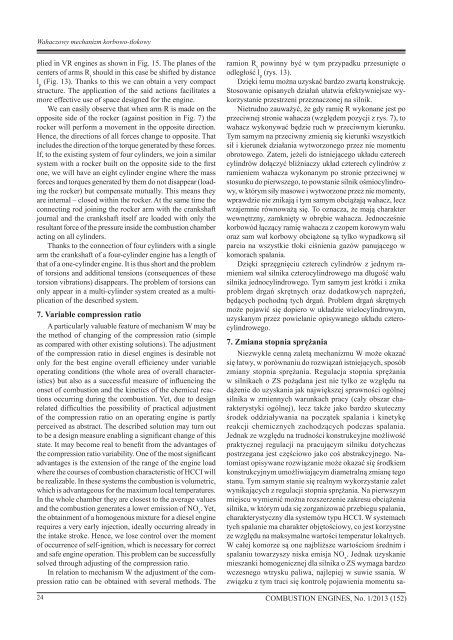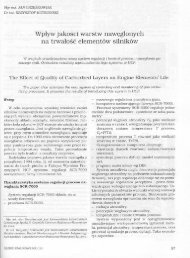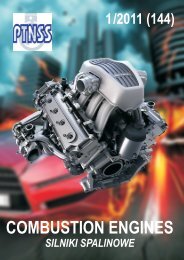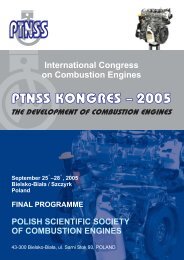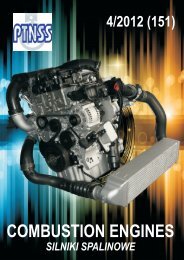Create successful ePaper yourself
Turn your PDF publications into a flip-book with our unique Google optimized e-Paper software.
Wahaczowy mechanizm korbowo-tłokowy<br />
plied in VR engines as shown in Fig. 15. The planes of the<br />
centers of arms R t<br />
should in this case be shifted by distance<br />
l p<br />
(Fig. 13). Thanks to this we can obtain a very compact<br />
structure. The application of the said actions facilitates a<br />
more effective use of space designed for the engine.<br />
We can easily observe that when arm R is made on the<br />
opposite side of the rocker (against position in Fig. 7) the<br />
rocker will perform a movement in the opposite direction.<br />
Hence, the directions of all forces change to opposite. That<br />
includes the direction of the torque generated by these forces.<br />
If, to the existing system of four cylinders, we join a similar<br />
system with a rocker built on the opposite side to the first<br />
one, we will have an eight cylinder engine where the mass<br />
forces and torques generated by them do not disappear (loading<br />
the rocker) but compensate mutually. This means they<br />
are internal – closed within the rocker. At the same time the<br />
connecting rod joining the rocker arm with the crankshaft<br />
journal and the crankshaft itself are loaded with only the<br />
resultant force of the pressure inside the combustion chamber<br />
acting on all cylinders.<br />
Thanks to the connection of four cylinders with a single<br />
arm the crankshaft of a four-cylinder engine has a length of<br />
that of a one-cylinder engine. It is thus short and the problem<br />
of torsions and additional tensions (consequences of these<br />
torsion vibrations) disappears. The problem of torsions can<br />
only appear in a multi-cylinder system created as a multiplication<br />
of the described system.<br />
7. Variable compression ratio<br />
A particularly valuable feature of mechanism W may be<br />
the method of changing of the compression ratio (simple<br />
as compared with other existing solutions). The adjustment<br />
of the compression ratio in diesel engines is desirable not<br />
only for the best engine overall efficiency under variable<br />
operating conditions (the whole area of overall characteristics)<br />
but also as a successful measure of influencing the<br />
onset of combustion and the kinetics of the chemical reactions<br />
occurring during the combustion. Yet, due to design<br />
related difficulties the possibility of practical adjustment<br />
of the compression ratio on an operating engine is partly<br />
perceived as abstract. The described solution may turn out<br />
to be a design measure enabling a significant change of this<br />
state. It may become real to benefit from the advantages of<br />
the compression ratio variability. One of the most significant<br />
advantages is the extension of the range of the engine load<br />
where the courses of combustion characteristic of HCCI will<br />
be realizable. In these systems the combustion is volumetric,<br />
which is advantageous for the maximum local temperatures.<br />
In the whole chamber they are closest to the average values<br />
and the combustion generates a lower emission of NO x<br />
. Yet,<br />
the obtainment of a homogenous mixture for a diesel engine<br />
requires a very early injection, ideally occurring already in<br />
the intake stroke. Hence, we lose control over the moment<br />
of occurrence of self-ignition, which is necessary for correct<br />
and safe engine operation. This problem can be successfully<br />
solved through adjusting of the compression ratio.<br />
In relation to mechanism W the adjustment of the compression<br />
ratio can be obtained with several methods. The<br />
ramion R t<br />
powinny być w tym przypadku przesunięte o<br />
odległość l p<br />
(rys. 13).<br />
Dzięki temu można uzyskać bardzo zwartą konstrukcję.<br />
Stosowanie opisanych działań ułatwia efektywniejsze wykorzystanie<br />
przestrzeni przeznaczonej na silnik.<br />
Nietrudno zauważyć, że gdy ramię R wykonane jest po<br />
przeciwnej stronie wahacza (względem pozycji z rys. 7), to<br />
wahacz wykonywać będzie ruch w przeciwnym kierunku.<br />
Tym samym na przeciwny zmienią się kierunki wszystkich<br />
sił i kierunek działania wytworzonego przez nie momentu<br />
obrotowego. Zatem, jeżeli do istniejącego układu czterech<br />
cylindrów dołączyć bliźniaczy układ czterech cylindrów z<br />
ramieniem wahacza wykonanym po stronie przeciwnej w<br />
stosunku do pierwszego, to powstanie silnik ośmiocylindrowy,<br />
w którym siły masowe i wytworzone przez nie momenty,<br />
wprawdzie nie znikają i tym samym obciążają wahacz, lecz<br />
wzajemnie równoważą się. To oznacza, że mają charakter<br />
wewnętrzny, zamknięty w obrębie wahacza. Jednocześnie<br />
korbowód łączący ramię wahacza z czopem korowym wału<br />
oraz sam wał korbowy obciążone są tylko wypadkową sił<br />
parcia na wszystkie tłoki ciśnienia gazów panującego w<br />
komorach spalania.<br />
Dzięki sprzęgnięciu czterech cylindrów z jednym ramieniem<br />
wał silnika czterocylindrowego ma długość wału<br />
silnika jednocylindrowego. Tym samym jest krótki i znika<br />
problem drgań skrętnych oraz dodatkowych naprężeń,<br />
będących pochodną tych drgań. Problem drgań skrętnych<br />
może pojawić się dopiero w układzie wielocylindrowym,<br />
uzyskanym przez powielanie opisywanego układu czterocylindrowego.<br />
7. Zmiana stopnia sprężania<br />
Niezwykle cenną zaletą mechanizmu W może okazać<br />
się łatwy, w porównaniu do rozwiązań istniejących, sposób<br />
zmiany stopnia sprężania. Regulacja stopnia sprężania<br />
w silnikach o ZS pożądana jest nie tylko ze względu na<br />
dążenie do uzyskania jak największej sprawności ogólnej<br />
silnika w zmiennych warunkach pracy (cały obszar charakterystyki<br />
ogólnej), lecz także jako bardzo skuteczny<br />
środek oddziaływania na początek spalania i kinetykę<br />
reakcji chemicznych zachodzących podczas spalania.<br />
Jednak ze względu na trudności konstrukcyjne możliwość<br />
praktycznej regulacji na pracującym silniku dotychczas<br />
postrzegana jest częściowo jako coś abstrakcyjnego. Natomiast<br />
opisywane rozwiązanie może okazać się środkiem<br />
konstrukcyjnym umożliwiającym diametralną zmianę tego<br />
stanu. Tym samym stanie się realnym wykorzystanie zalet<br />
wynikających z regulacji stopnia sprężania. Na pierwszym<br />
miejscu wymienić można rozszerzenie zakresu obciążenia<br />
silnika, w którym uda się zorganizować przebiegu spalania,<br />
charakterystyczny dla systemów typu HCCI. W systemach<br />
tych spalanie ma charakter objętościowy, co jest korzystne<br />
ze względu na maksymalne wartości temperatur lokalnych.<br />
W całej komorze są one najbliższe wartościom średnim i<br />
spalaniu towarzyszy niska emisja NO x<br />
. Jednak uzyskanie<br />
mieszanki homogenicznej dla silnika o ZS wymaga bardzo<br />
wczesnego wtrysku paliwa, najlepiej w suwie ssania. W<br />
związku z tym traci się kontrolę pojawienia momentu sa-<br />
24 <strong>COMBUSTION</strong> <strong>ENGINES</strong>, No. 1/2013 (152)


